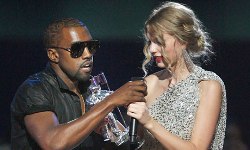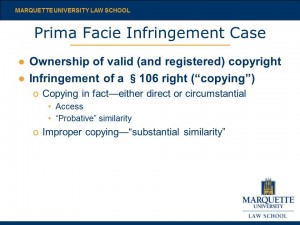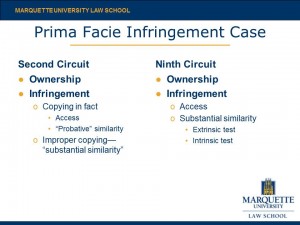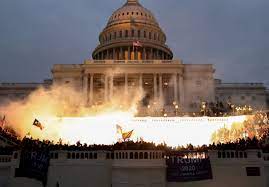 At least, not if Mudville is populated by copyright professors; for the mighty Seventh Circuit has struck out. In Peters v. West (Kanye West, that is, or as LEXIS is now abbreviating the case name, “W.”), the Seventh Circuit, in an opinion written by the highly regarded Judge Wood, has badly bungled the already confused test for establishing a copyright infringement claim. I’ma let you finish, Judge Wood, but Judge Newman had one of the best explanations of this test of all time.
At least, not if Mudville is populated by copyright professors; for the mighty Seventh Circuit has struck out. In Peters v. West (Kanye West, that is, or as LEXIS is now abbreviating the case name, “W.”), the Seventh Circuit, in an opinion written by the highly regarded Judge Wood, has badly bungled the already confused test for establishing a copyright infringement claim. I’ma let you finish, Judge Wood, but Judge Newman had one of the best explanations of this test of all time.
The elements of a prima facie copyright infringement claim have long been confusing to students, lawyers, judges — pretty much everyone. (A brief copyright lesson follows; if this is old hat to you, skip 4 paragraphs down.) Essentially, there are only two elements: ownership and infringement. But the second element is broken down further into a set of sub-elements, and courts have long had difficulty explaining the content and the relationship of the various sub-elements clearly. The basic idea, however, long ago expressed in Second Circuit opinions by Judges Learned Hand and Jerome Frank, is that proving infringement is supposed to be a two-part process: proving that the defendant actually copied material from the plaintiff’s work, and proving that the amount copied passes some sort of threshold for materiality.
There are two significant points of confusion with the test. The first is that the “actual copying” part of the test can get satisfied two different ways, depending on the nature of the proof. First, if there is direct evidence of copying — say, an admission from the defendant, or letters from the defendant saying “Make the sculpture more like the photo” — then the actual copying prong can be satisfied just on the basis of that evidence, and the only remaining determination is whether the amount copied passes the threshold for liability. But if — and ONLY IF (picture me jumping up and down as I say this in class) — there is no direct evidence of actual copying, the plaintiff can establish actual copying circumstantially through a further two-part sub-test: access to the plaintiff’s work, and enough similarity between the two works to make it more probable than not that some portion was actually copied. Note that proof of “access” only becomes an issue as part of a circumstantial case for actual copying; it is not some sort of independent requirement in order to establish infringement. And even if “access” is established, the plaintiff still must show some amount of similarity between the two works to make out actual copying — itself only half of the necessary showing to demonstrate infringement. Here it is outlined:
At this point we run in the second problem with the test: just to make sure that it was extra confusing, courts have long referred to the amount of similarity necessary to establish a circumstantial case of actual copying, and the amount of similarity necessary to pass the liability threshold after actual copying has been established, by exactly the same name: “substantial similarity.” Practitioners and judges have noticed since at least the 1970s that this was causing a significant amount of confusion, and have proposed rebranding one or both standards: Alan Latman proposed “probative similarity” for the circumstantial sub-element of actual copying, and Judge Newman in the Ringgold opinion referenced above proposed “actionable copying” for the liability threshold. But none have caught on, and worse, in the early 1970s, the Ninth Circuit badly botched the whole distinction between actual copying and actionable copying by merging the two similarity sub-elements together into a single “substantial similarity” requirement, itself divided into two parts: an “extrinsic” test comparing the various pieces of the two works, and an “intrinsic” test of their gestalt similarity. This has left “access” hanging as an independent requirement for all infringement cases, even though it’s really only part of a circumstantial case, and has obliterated any notion that copying and liability are two separate determinations. (More on that below.) Here’s the best I can make out of the Ninth Circuit test, laying it side-by-side with the Second Circuit test:
(Copyright geeks can begin reading again here.) For the most part, the other circuits have followed the Second Circuit’s way of laying out the elements of an infringement claim, and have declined to adopt the Ninth Circuit’s reorganization. But that’s no longer true; the Seventh Circuit seems now to have collapsed actual copying and actionable copying, just like the Ninth Circuit has. Things get off to a shaky start right off the bat when the court states the test for infringement:
Proving infringement of a copyright owner’s exclusive right under 17 U.S.C. § 106(1) (the reproduction right) requires proof of “(1) ownership of a valid copyright, and (2) copying of constituent elements of the work that are original.” Feist Publ’ns, Inc. v. Rural Tel. Serv. Co., 499 U.S. 340, 361 (1991); JCW Invs., Inc. v. Novelty, Inc., 482 F.3d 910, 914 (7th Cir. 2007).
It’s true, unfortunately, that Feist contains the quoted language, but it’s nevertheless not a good summary of the elements of infringement. More than mere proof of actual copying has always been required; that copying must rise to the level of liability. The issue in Feist, of course, was originality, and the liability threshold was not the focus. Feist cited as support for its two-element test Harper & Row v. Nation Enterprises, 471 U.S. 539, 548 (1985), but Harper & Row does not set forth any elements of an infringement claim at the cited page; instead it merely states that similarities in unprotected expression do not constitute infringement. JCW is an earlier opinion by Judge Wood, on a different procedural posture, in which she quoted the same language from Feist as supplying the test for infringement.
Things go quickly downhill from there.
The standard for copying is surprisingly muddled. Where direct evidence, such as an admission of copying, is not available (as is typically the case, see JCW, 482 F.3d at 915), a plaintiff may prove copying by showing that the defendant had the opportunity to copy the original (often called “access”) and that the two works are “substantially similar,” thus permitting an inference that the defendant actually did copy the original. The various efforts to define these two key concepts, however, have unfortunately had the unintended effect of obscuring rather than clarifying the issues. This court has said that substantial similarity can be shown by evidence of “actual copying” and “improper appropriation.” Incredible Techs., Inc. v. Virtual Techs., Inc., 400 F.3d 1007, 1011 (7th Cir. 2005).
That last sentence is where the analysis goes off the rails. As discussed above, there are two distinct substantial similarity tests that establish separate sub-elements of infringement; Peters portrays them as one test that can be established two different ways. Indeed, the actual copying sub-element seems to have been inverted so that it is part of the test for “substantial similarity,” rather than vice versa. In Judge Wood’s defense, the Seventh Circuit has been building towards this for a while. Incredible Technologies, by Judge Evans, cites Feist in the same way, describes substantial similarity as a sub-element of actual copying, and then notes that “[t]he test for substantial similarity may itself be expressed in two parts: whether the defendant copied from the plaintiff’s work and whether the ‘copying, if proven, went so far as to constitute an improper appropriation.'” Nevertheless, the Peters court has taken that and boiled it down to a test for actual copying that has as sub-elements access and substantial similarity, which in turn is shown by demonstrating actual copying and improper appropriation. Actual copying is now in part (but only in part!) proved by actual copying.
Having gone of the rails, the analysis starts rapidly somersaulting down a steep incline:
Thus, we permit copying to be proven by evidence of access, actual copying, and improper appropriation. Vince P argues that we should adopt a hybrid of our own approach and the one that he argues prevails in the Second Circuit. That court, he contends, permits actual copying to be proven by “access” and “probative similarity” (which is distinct from substantial similarity). Appellant’s Br. at 26 (citing Laureyssens v. Idea Group, Inc., 964 F.2d 131, 140 (2d Cir. 1992)). Putting these tests together, he seems to want us to require proof of access, improper appropriation, and actual copying by means of showing probative similarity and access (again).
The appellant’s brief was not as clear on this point as it could have been, partly because it follows earlier Seventh Circuit language in referring to substantial similarity as in part proved by actual copying, when in fact it’s the reverse. But the brief eventually gets it basically right:
The first prong, “copying,” can be established by showing access and some degree of similarity which would make independent creation unlikely. It may or may not be substantial. It looks for objective similarities, such as similar words or common errors. This is sometimes referred to as “probative similarity.” See, Laureyssens v. Idea Group, Inc., 964 F.2d 131, 140 (2d Cir. 1992); Latman, Probative Similarity as Proof of Copying: Toward Dispelling Some Myths in Copyright Infringement, 90 Columbia L. Rev. 1187, 1204 (1990). . . .
If there is access and sufficiently objective similarities to be probative of copying, one moves to the second part of the substantial similarity analysis. The second prong, “improper appropriation,” looks to the response of the “ordinary observer.” Atari, 672 F.2d at 614. . . .
But Judge Wood took the appellant to be arguing that access and probative similarity should be added to the topsy-turvy definition she had extracted from previous cases, not substituted for part of it. Needless to say, building the test for infringement out to five redundant sub-elements would not improve matters. So, after noting that other circuits (some of which correctly summarize the test) seem also not to be describing the Seventh Circuit version of things, Judge Wood decides to wipe the slate clean:
Despite all of this confusing nomenclature, this strikes us as a “pseudo-conflict”: despite the conflicting and confusing verbiage, the outcomes do not appear to differ. Fundamentally, proving the basic tort of infringement simply requires the plaintiff to show that the defendant had an actual opportunity to copy the original (this is because independent creation is a defense to copyright infringement), and that the two works share enough unique features to give rise to a breach of the duty not to copy another’s work. Our analysis will follow this structure.
The end result is an all-new, never-before-seen set of sub-elements for infringement: (1) access, and (2) sharing enough unique features to give rise to a breach of the duty not to copy another’s work. Given the earlier discussion, it’s hard to tell if (2) requires anything more than actual copying of protected expression. Perhaps not. The court, applying sub-element (2) to test the sufficiency of the plaintiff’s complaint, declares later that in order to “prove similarity” (in his complaint!), Peters “must show that West actually copied his song by pointing to similarities between the two works.” (Emphasis added.)
Having gone on far too long for a blog post, I’ll break out my diagnosis of the problems with the Seventh Circuit test in a second post, and then maybe some thoughts about what Peters says about pleading in a third.
Cross-posted at Madisonian.net.



